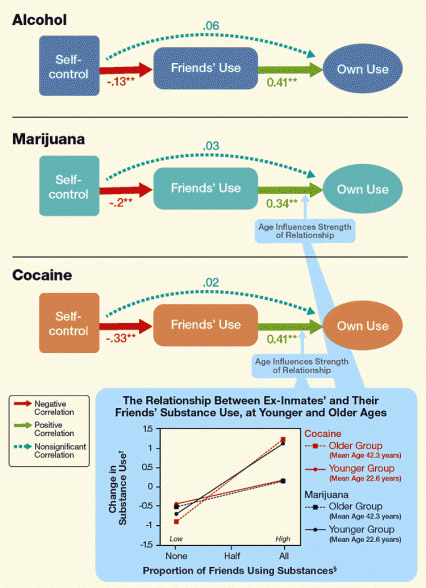- Text description
-
The figure shows that inmates' pre-release self-assessment of their ability to exercise self-control to avoid drug use had only an indirect relationship to their actual use of alcohol, marijuana, and cocaine one year following release. One year following their release, inmates who had rated their self-control higher had lower proportions of friends who used drugs, and having fewer drug-using friends correlated with less drug use
An inset in the figure shows that the impact of having drug-using friends on inmates’ own drug use varied by age and drug. Having more drug-using friends was associated with a larger positive increment in cocaine use difference among older, as compared to younger, ex-inmates. In contrast, having more drug-using friends was associated with a larger positive increment in marijuana use among younger, as compared to older, ex-inmates.
When the goal is to avoid using alcohol and illicit substances after being released from jail, it’s who one’s friends are that counts most. Self-control is important because it helps a person have the right kind of friends.
Those are the lessons of a NIDA-supported study of 322 male and female inmates of a county jail. Dr. Elizabeth Malouf and colleagues at George Mason University in Fairfax, Virginia, asked the inmates to rate their self-control prior to being released, and to report on their own and their friends’ use of alcohol and illicit drugs in a followup visit 1 year later.
At the followup, three-fourths of the ex-inmates reported that they drank alcohol, one-third reported using marijuana, and 28 percent reported using cocaine; 43 percent reported at least one symptom of substance dependence.
The ex-inmates’ levels of substance use and dependence symptoms 1 year out correlated with the proportion of people in their friendship circles who used substances. Participants with few or no substance-using friends reported less use than they had engaged in before their incarceration, and those whose friends mostly or all used reported increased use. Each step up in the proportions of users among participants’ friends (none, a few, some, most, all) was associated with a 0.3- to 0.4-point increase in participants’ scores on a scale comparing their current to their pre-incarceration frequency of use of alcohol, marijuana, and cocaine, and substance dependence symptoms (green arrows in graphic).
Ex-inmates who rated their self-control higher before re-entering the community reduced their alcohol and illicit drug use during the following year, compared to their levels prior to incarceration. However, self-control exerted its beneficial effect almost entirely through reducing the proportion of substance users in participants’ friendship circles (red arrows in graphic). Once self-control’s indirect effect via the choice of friends was taken into account, the remaining direct effect of self-control on use was insignificant (blue arrows).
The age of an inmate influenced the strength of the relationship between one’s choice of friends and one’s use of marijuana and cocaine, but not alcohol. For marijuana, choice of friends was less predictive of use among older study subjects compared with younger ones. For cocaine, the opposite was true—older users were more likely to have friends who used cocaine. The researchers suggest that because cocaine is strongly addictive, adults who have used it over a number of years may fail to maintain relationships with nonusers.
Dr. Redonna Chandler, chief of NIDA’s Services Research Branch, comments, “Dr. Malouf found that prisoners’ pre-release self-assessment of their ability to use self-control to avoid drug use had only an indirect relationship to their actual drug use a year later. The finding highlights the fact that many prisoners develop a false sense of security about their ability to resist drugs. Imprisonment removes people from the environmental cues that trigger their cravings, which can lead them to think that they are cured of their addiction. However, when they get out and encounter the cues again, they may be just as susceptible as they were before they went in.”
This study was supported by NIH grants: DA029397 and DA014694.
Source
Malouf, E.; Stuewig, J.; and Tangney, J. Self-control and jail inmates’ substance misuse post-release: Mediation by friends’ substance use and moderation by age. Addictive Behaviors 37:1198–1204, 2012. Abstract

